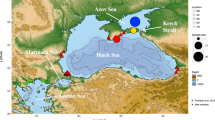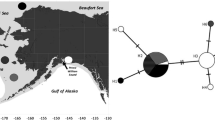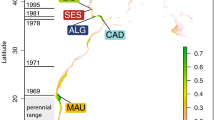Abstract
Marine and estuarine species often exhibit patterns of genetic variability consistent with demographic disequilibrium caused by reduced population sizes, possibly associated with glacial cycles. With one exception, previous studies in southeastern Australia have concentrated on taxa with broad distributions for which convincing scenarios to explain range size reductions are generally lacking. This study investigates the genetic structure of the mussel Austromytilus rostratus, which is a limited-range taxon endemic to the region, to examine the role that demographic instability may have played in its phylogeographic history. A. rostratus presently has no marked geographic structure in mitochondrial cytochrome c oxidase subunit I DNA sequences, although it exhibits very high diversity of haplotypes, with many restricted to one of the three regions where the species is particularly abundant. FST values between these regions are low although they are separated by areas of low population density. Sequence mismatch distributions and population genetic statistics suggest that demographic disequilibrium has occurred in A. rostratus overall and within each region. The species may have experienced population size changes, possibly through a decrease in its distribution during climate cycles to southern refugia at glacial minima or to northern refugia at glacial maxima. Under either scenario, however, the operation of indirect factors such as changes in the ranges of predators, interspecific competition or nutrient availability would probably need to be invoked to explain severe reductions in population size.


Similar content being viewed by others
References
Ayre DJ, Minchinton TE, Perrin C (2009) Does life history predict past and current connectivity for rocky intertidal invertebrates across a marine biogeographic barrier? Mol Ecol 18:1887–1903
Bennett I, Pope EC (1953) Intertidal zonation of the exposed rocky shores of Victoria, together with a rearrangement of the biogeographical provinces of temperate Australian shores. Aust J Mar Freshw Res 4:105–159
Bennett I, Pope EC (1960) Intertidal zonation of the exposed rocky shores of Tasmania and its relationship with the rest of Australia. Aust J Mar Freshw Res 11:182–221
Bester-van der Merwe AE, Roodt-Wilding R, Volckaert FA, D’Amato ME (2011) Historical isolation and hydrodynamically constrained gene flow in declining populations of the South-African abalone, Haliotis midae. Conserv Genet 12:543–555
Bostock HC, Opdyke BN, Gagan MK, Kiss AE, Fifield LK (2006) Glacial/interglacial changes in the East Australian current. Clim Dynam 26:645–659
Bureau of Meteorology (2016) Annual SST averages (°C) for 1961–1990. Available at http://www.bomgovau/climate/change/indexshtml#tabs=Tracker&tracker=average–maps. Accessed 2 August, 2016
Colgan DJ (1980) Theoretical and practical studies on genetic fitness. PhD thesis, University of Melbourne
Colgan DJ (1981) Spatial and temporal variation in the genotypic frequencies of the mussel Brachidontes rostratus. Heredity 46:197–208
Colgan DJ (1987) Deficits of heterozygotes in relation to selective interaction between loci in the mussels Brachidontes rostratus and Xenostrobus pulex. Heredity 59:355–362
Colgan DJ (2015) The marine and estuarine phylogeography of the coasts of southeastern Australia. Mar Freshw Res. doi:https://doi.org/10.1071/MF15106
Colgan DJ, Da Costa P (2009) DNA haplotypes cross species and biogeographic boundaries in estuarine hydrobiid snails of the genus Tatea. Mar Freshw Res 60:861–872
Colgan DJ, Da Costa P (2013a) Possible drivers of biodiversity generation in the Siphonaria of southeastern Australia. Mar Biodivers 43:73–85
Colgan DJ, Da Costa P (2013b) Recent evolutionary dynamism in three pulmonate gastropods from south-eastern Australia. Estuar Coast Shelf Sci 128:1–8
Colgan DJ, Da Costa P (2013c) Invasive and non-invasive lineages in Xenostrobus (Bivalvia: Mytilidae). Molluscan Res 33:272–280
Colgan DJ, Middelfart PM (2011) Mytilus mitochondrial DNA haplotypes in southeastern Australia. Aquat Biol 12:47–53
Colgan DJ, Middelfart P, Golding R, Criscione F (2009) Monitoring the response of NSW bivalves to climate change. Final report to the Environmental Trust for Grant 2008/RD/0071 Australian Museum, Sydney
Colgan DJ, Paxton JR (1997) Biochemical systematics and recognition of a western stock of the common gemfish, Rexea solandri (Scombroidea: Gempylidae) in Australia. Mar Freshw Res 48:103–118
Coulson LA, Perrin C, Roberts DG, Minchinton TE, Ayre DJ (2011) Can limited dispersal or biotic interaction explain the declining abundance of the whelk, Morula marginalba, at the edge of its range? Biol J Linn Soc 103:849–862
Cresswell G (2000) Currents of the continental shelf and upper slope of Tasmania. Papers Proc Roy Soc Tasmania 133:21–30
Dawson MN (2001) Phylogeography in coastal marine animals: a solution from California? J Biogeogr 28:723–736
de Aranzamendi MC, Bastida R, Gardenal CN (2014) Genetic population structure in Nacella magellanica: evidence of rapid range expansion throughout the entire species distribution on the Atlantic coast. J Exp Mar Biol Ecol 460:53–61
Excoffier L, Laval G, Schneider S (2005) Arlequin ver 3.0: an integrated software package for population genetics data analysis. Evol Bioinformatics Online 1:47–50
Folmer O, Black M, Hoeh W, Lutz R, Vrijenhoek R (1994) DNA primers for amplification of mitochondrial cytochrome c oxidase subunit I from diverse metazoan invertebrates. Mol Mar Biol Biotechnol 3:294–299
Fraser CI, Spencer HG, Waters JM (2009) Glacial oceanographic contrasts explain phylogeography of Australian bull kelp. Mol Ecol 18:2287–2296
Fu Y-X (1996) New statistical tests of neutrality for DNA samples from a population. Genetics 143:557–570
Gallagher SJ, Greenwood DR, Taylor D, Smith AJ, Wallace MW, Holdgate GR (2003) The Pliocene climatic and environmental evolution of southeastern Australia: evidence from the marine and terrestrial realm. Palaeogeogr Palaeoclimat Palaeoecol 193:349–382
Garrido-Ramos MA, Stewart DT, Sutherland BW, Zouros E (1998) The distribution of male-transmitted and female-transmitted mitochondrial DNA types in somatic tissues of blue mussels: implications for the operation of doubly uniparental inheritance of mitochondrial DNA. Genome 41:818–824
Glez-Peña D, Gómez-Blanco D, Reboiro-Jato M, Fdez-Riverola F, Posada D (2010) ALTER: program-oriented format conversion of DNA and protein alignments. Nucl Acids Res 38(suppl. 2):W14–W18
Golding RE, Colgan DJ, Nelmes G, Reutelshöfer T (2011) Sympatry and allopatry in the deeply divergent mitochondrial DNA clades of the estuarine pulmonate gastropod genus Phallomedusa (Mollusca, Gastropoda). Mar Biol 158:159–169
González-Wevar CA, Hüne M, Cañete JI, Mansilla A, Nakano T, Poulin E (2012) Towards a model of postglacial biogeography in shallow marine species along the Patagonian Province: lessons from the limpet Nacella magellanica (Gmelin, 1791). BMC Evol Biol 12:1
Grove S, de Little R (2013) The coastal marine molluscs of King Island: March 2013 trip report and an updated checklist. Tasmanian Museum and Art Gallery, Hobart
Hall TA (1999) BioEdit: a user-friendly biological sequence alignment editor and analysis program for Windows 95/98/NT. Nucl Acids Symp Ser 41:95–98
Harpending HC, Batzer MA, Gurven M, Jorde LB, Rogers AR, Sherry ST (1998) Genetic traces of ancient demography. P Natl Acad Sci USA 95:1961–1967
Hindell JS, Quinn GP (2000) Effects of sewage effluent on the population structure of Brachidontes rostratus (Mytilidae) on a temperate intertidal rocky shore. Mar Freshw Res 51:543–551
Hoeh WR, Stewart DT, Saavedra C, Sutherland BW, Zouros E (1997) Phylogenetic evidence for role-reversals of gender-associated mitochondrial DNA in Mytilus (Bivalvia: Mytilidae). Mol Biol Evol 14:959–967
King RJ (1972) The distribution and zonation of intertidal organisms in Bass Strait. Proc Roy Soc Victoria 85:145–162
Kumar S, Stecher G, Tamura K (2016) MEGA7: Molecular Evolutionary Genetics Analysis version 7.0 for bigger datasets. Mol Biol and Evol 33:1870–1874
Lamprell K, Healy J (1998) Bivalves of Australia, vol 2. Backhuys Publishers, Leiden
Laseron CF (1956) New South Wales mussels. Aust Zool 12:263–283
Li J-C, Ó Foighil D, Park J-K (2013) Triton’s trident: cryptic Neogene divergences in a marine clam (Lasaea australis) correspond to Australia’s three temperate biogeographic provinces. Mol Ecol 22:1933–1946
Macpherson JH, Gabriel CJ (1962) Marine molluscs of Victoria. Melbourne University Press, Melbourne
McWilliam RA, Minchinton TE, Ayre DJ (2013) Despite prolonged association in closed populations, an intertidal predator does not prefer abundant local prey to novel prey. Biol J Linn Soc 108:812–820
Miller MA, Pfeiffer W, Schwartz T (2010) Creating the CIPRES Science Gateway for inference of large phylogenetic trees, In: Proceedings of the Gateway Computing Environments Workshop (GCE), 14 Nov. 2010, New Orleans, pp. 1–8##
Miller AD, Versace VL, Matthews TG, Montgomery S, Bowie KC (2013) Ocean currents influence the genetic structure of an intertidal mollusc in southeastern Australia—implications for predicting the movement of passive dispersers across a marine biogeographic barrier. Ecol Evol 3:1248–1261
Nürnberg D, Brughmans N, Schönfeld J, Ninnemann U, Dullo C (2004) Paleo-export production, terrigenous flux and sea surface temperatures around Tasmania—implications for glacial/interglacial changes in the subtropical convergence zone in: Exon NF, Kennett JP, Malone MJ (eds) The cenozoic Southern Ocean: tectonics, sedimentation and climate change between Australia and Antarctica. American Geophysical Union, Washington DC, Geophysical Monograph Series 151:291–317
Ompi M (2011) Settlement behaviour and size of mussel larvae from the family Mytilidae (Brachidontes erosus (Lamarck, 1819), Brachidontes rostratus (Dunker, 1857), Trichomya hirsutus (Lamarck, 1819) and Mytilus galloprovincialis Lamarck, 1819). J Coast Dev 13:215–227
Pattengale ND, Alipour M, Bininda-Emonds ORP, Moret BME, Stamatakis A (2010) How many bootstrap replicates are necessary? J Comput Biol 17:337–354
Peake AJ, Quinn GP (1993) Temporal variation in species-area curves for invertebrates in clumps of an intertidal mussel. Ecography 16:269–277
Ramos-Onsins SE, Rozas J (2002) Statistical properties of new neutrality tests against population growth. Mol Biol Evol 19:2092–2100
Reynolds TV, Matthee CA, Von Der Heyden S (2014) The influence of Pleistocene climatic changes and ocean currents on the phylogeography of the southern African barnacle, Tetraclita serrata (Thoracica; Cirripedia). PLoS One 9:e102115
Ross PM, Hogg ID, Pilditch CA, Lundquist CJ (2009) Phylogeography of New Zealand’s coastal benthos. New Zeal J Mar Freshw Res 43:1009–1027
Rozas J, Sánchez-DelBarrio JC, Messeguer X, Rozas R (2002) DnaSP, DNA polymorphism analyses by the coalescent and other methods. Bioinformatics 19:2496–2497
Sikes EL, Howard WR, Samson CR, Mahan TS, Robertson LG, Volkman JK (2009) Southern Ocean seasonal temperature and Subtropical Front movement on the South Tasman Rise in the late Quaternary. Paleoceanography 24:PA2201
Skibinski DOE, Gallagher C, Beynon CM (1994) Sex-limited mitochondrial DNA transmission in the marine mussel Mytilus edulis. Genetics 138:801–809
Stamatakis A, Hoover P, Rougemont J (2008) A rapid bootstrap algorithm for the RAxML web-servers. Syst Biol 75:758–771
Swofford DL (2003) PAUP: phylogenetic analysis using parsimony, version 4.0. Laboratory of Molecular Systematics, Smithsonian Institution, Washington
Tajima F (1989) Statistical method for testing the neutral mutation hypothesis by DNA polymorphism. Genetics 123:585–595
Tamura K, Battistuzzi FU, Billing-Ross P, Murillo O, Filipski A, Kumar S (2012) Estimating divergence times in large molecular phylogenies. Proc Nat Acad Sci USA 109:19333–19338
Terranova MS, Lo Brutto S, Arculeo M, Mitton JB (2007) A mitochondrial phylogeography of Brachidontes variabilis (Bivalvia: Mytilidae) reveals three cryptic species. J Zool Syst Evol Res 45:289–298
Teske PR, Von der Heyden S, McQuaid CD, Barker NP (2011) A review of marine phylogeography in southern Africa. S Afr J Science 107:43–53
Thompson JD, Gibson TJ, Plewniak F, Jeanmougin F, Higgins DG (1997) The CLUSTAL X windows interface: flexible strategies for multiple sequence alignment aided by quality analysis tools. Nucl Acids Res 25:4876–4882
Trovant B, Basso NG, Orensanz JM, Lessa EP, Dincao F, Ruzzante DE (2016) Scorched mussels (Brachidontes spp., Bivalvia: Mytilidae) from the tropical and warm-temperate southwestern Atlantic: the role of the Amazon River in their speciation. Ecol Evol 6:1778–1798
Trovant B, Orensanz JL, Ruzzante DE, Stotz W, Basso NG (2015) Scorched mussels (Bivalvia: Mytilidae: Brachidontinae) from the temperate coasts of South America: phylogenetic relationships, trans-Pacific connections and the footprints of Quaternary glaciations. Mol Phylogenet Evol 82:60–74
Trovant B, Ruzzante DE, Basso NG, Orensanz JM (2013) Distinctness, phylogenetic relations and biogeography of intertidal mussels (Brachidontes, Mytilidae) from the south-western Atlantic. J Mar Biol Assoc UK 93:1843–1855
Waters JM (2008) Marine biogeographical disjunction in temperate Australia: historical landbridge, contemporary currents, or both? Div Dist 14:692–700
Waters JM, King TM, O’Loughlin PM, Spencer HG (2005) Phylogeographical disjunction in abundant high-dispersal littoral gastropods. Mol Ecol 14:2789–2802
Weber XA, Edgar GJ, Banks SC, Waters JM, Fraser CI (2017) A morphological and phylogenetic investigation into divergence among sympatric Australian southern bull kelps (Durvillaea potatorum and D. amatheiae sp. nov.) Mol Phylogenet Evol 107:630–643
Womersly HBS, Edmonds SJ (1958) A general account of the intertidal ecology of South Australian coasts. Aust J Mar and Freshw Res 9:217–260
Wu L, Cai W, Zhang L, Nakamura H, Timmermann A, Joyce T, McPhaden MJ, Alexander M, Qiu B, Visbeck M, Chang P, Giese B (2012) Enhanced warming over the global subtropical western boundary currents. Nat Clim Chang 2:161–166
York KL, Blacket MJ, Appleton BR (2008) The Bassian Isthmus and the major ocean currents of southeast Australia influence the phylogeography and population structure of a southern Australian intertidal barnacle Catomerus polymerus (Darwin). Mol Ecol 17:1948–1961
Zouros E (2013) Biparental inheritance through uniparental transmission: the doubly uniparental inheritance (DUI) of mitochondrial DNA. Evol Biol 40:1–31
Acknowledgements
I thank the Australian Museum and the New South Wales Environmental Trust for the financial support, Pam Da Costa for DNA sequencing and three anonymous reviewers for helpful comments on a previous version of this manuscript. Collections for this project were undertaken under Permits F86/2163(A) (New South Wales Fisheries Research Permit), 7118 (Tasmania DPIW permit) and RP972 (Victoria General Research Permit).
Funding
This research was funded by the Australian Museum and the New South Wales Environmental Trust (Grant 2008/RD/0071).
Author information
Authors and Affiliations
Corresponding author
Ethics declarations
Conflict of interest
The author declares that he has no conflict of interest.
Ethical approval
All applicable international, national, and/or institutional guidelines for the care and use of animals were followed by the authors.
Sampling and field studies
All necessary permits for sampling and observational field studies have been obtained by the authors from the competent authorities and are mentioned in the acknowledgements, if applicable.
Additional information
Communicated by V. Urgorri
Electronic supplementary material
ESM 1
Supplementary Figure. Habitat of Austromytilus rostratus at Bicheno, Tasmania (locality I) (left photograph) and Haycock Headland (locality C) (right photograph). The clumps of mussels at Bicheno are almost wholly comprised of A. rostratus whereas the species is found only as isolated groups in crevices at Haycock Headland. (PDF 5118 kb)
Rights and permissions
About this article
Cite this article
Colgan, D.J. Population genetic instability and the phylogeography of the mussel Austromytilus rostratus (Dunker, 1857) (Bivalvia: Mytilidae). Mar Biodiv 49, 887–896 (2019). https://doi.org/10.1007/s12526-018-0872-y
Received:
Revised:
Accepted:
Published:
Issue Date:
DOI: https://doi.org/10.1007/s12526-018-0872-y




